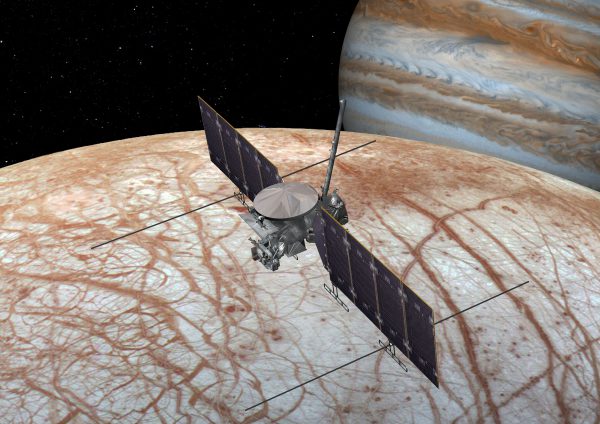
For a long time now, there has been growing interest in sending a mission back to Jupiter to better study one moon in particular: Europa. Previous missions such as Voyager and Galileo showed us this world up close for the first time, revealing a place that maybe, just maybe, is home to some kind of life. On the outside, Europa is cold and frozen, like an airless version of Antarctica, with its surface completely composed of ice. But deeper down, as those probes found, there is a global ocean of water deeper than any oceans on Earth. In more recent years and months, a new NASA mission to Europa has finally started to take shape, with a launch tentatively scheduled for 2022. As often happens, however, the mission is facing possible budget cuts in 2017.
As reported by SpaceNews, the mission planning and development is still continuing, but there may be a squeeze in funding for the next fiscal year.
“There is this squeeze in FY17 that we have,” said Bob Pappalardo, the project scientist at the Jet Propulsion Laboratory. “We’re asking the instrument teams and various other aspects of the project, given that squeeze, what will it take in the out years to maintain that ’22 launch. We’re actively pursuing that question as we speak.”
During presentations at NASA’s Outer Planets Assessment Group (OPAG) in Flagstaff, Ariz., on Aug. 11, it was announced that NASA is looking for ways to cut costs in 2017, but also keep the mission on track for a launch in 2022.
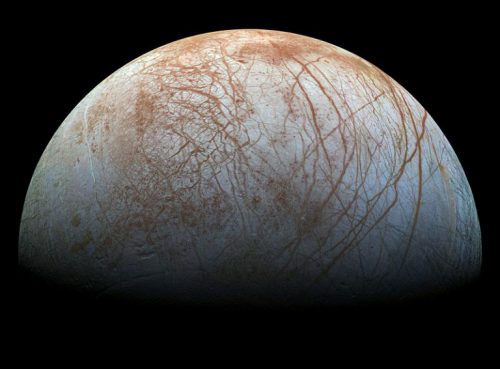
As with any large space missions, the problem is budgeting within NASA’s limited resources. In 2016, NASA received $175 million from Congress, but for 2017 NASA has requested only $49.6 million. This kind of thing has happened before, and indeed last year NASA received more funds than it had initially requested. Also, right now a House appropriations bill for 2017 provides $260 million, but those funds have as of yet not been specifically allocated by the Senate.
Does NASA requesting such lower amounts mean it is losing interest in the mission? Not necessarily.
“Everyone is aware of how supportive and generous Congress has been of this mission, and I’m happy to say that that support and encouragement is now shared by the administration, and by NASA as well,” said Curt Niebur, the program scientist for the mission at NASA Headquarters. “Everybody is on board the Europa Clipper and getting this mission to the launch pad as soon as our technical challenges and our budget will allow.”
It’s a cause for concern, but to say the mission is in danger of being cancelled is premature at this point. In previous years, the House has prevailed when it comes to allocating funds for NASA missions. There had also been some concern that the mission may be delayed several years, but as it stands now, with current funding, the mission is still on track for a 2022 launch. That date was set by Congress in its 2016 appropriation bill and also affirmed in the House version of a 2017 spending bill.
There has also been much debate as to what kind of mission it will be. Earlier mission concepts called for an orbiter, but the current mission, as designed, would see the probe, known as Europa Clipper, make 45 close flybys of Europa. Onboard instruments would analyze the interior of the moon, below the outer ice shell, to learn about conditions in the subsurface ocean. As of now, there are no plans to add anything else to that, such as including smaller probes on the main spacecraft.
“The additional science value provided by these additions was not commensurate with the associated impact to resources, to accommodation, to cost,” Niebur said. “There just wasn’t enough science there to balance that out.”
Instruments being designed for the flyby spacecraft include:
- Plasma Instrument for Magnetic Sounding (PIMS)
- Interior Characterization of Europa using MAGnetometry (ICEMAG)
- Mapping Imaging Spectrometer for Europa (MISE)
- Europa Imaging System (EIS)
- Radar for Europa Assessment and Sounding: Ocean to Near-surface (REASON)
- Europa THermal Emission Imaging System (E-THEMIS)
- MAss SPectrometer for Planetary EXploration/Europa (MASPEX)
- Ultraviolet Spectrograph/Europa (UVS)
- SUrface Dust Mass Analyzer (SUDA)
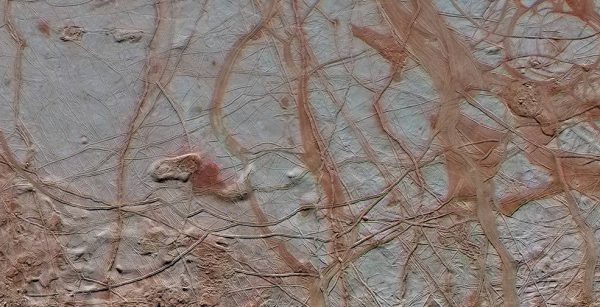
There had also been a lot of talk about including a small lander on the mission, which was supported by Congress, but at this point it seems it won’t be part of Europa Clipper. It is, however, being studied as a possible follow-up mission, for launch in 2024. According to Niebur, NASA is spending about $35 to $40 million of the $175 million, as allocated for the Europa mission in 2016, for either a lander study or related technology development work. The Europa Clipper mission itself will be complex enough, so it might make sense to have a lander as a separate mission, if the 2022 launch for Europa Clipper is to be achieved. Currently, NASA is working on a “pre-Phase A” study of a Europa lander mission while a science definition team (SDT) works on the science goals of such a mission. As envisaged, the lander could be lowered to Europa’s surface in a manner similar to how the Curiosity rover landed on Mars, using the “skycrane” system. The lander isn’t a for-sure thing yet, as NASA has noted, but it is being seriously considered:
“We’re interested in a mission, but we don’t know if a worthwhile mission is possible given the constraints we’re under,” Niebur said. “It’s up to the pre-Phase A study and the SDT to come up with a mission concept that doable and worthwhile, and present it to NASA.” He added: “Let’s see if a worthwhile mission is doable. I’m confident they’ll prove that’s the case.”
The possibility of a lander was also mentioned by Niebur in an article for RocketSTEM by Sherry Valare (who is also with AmericaSpace):
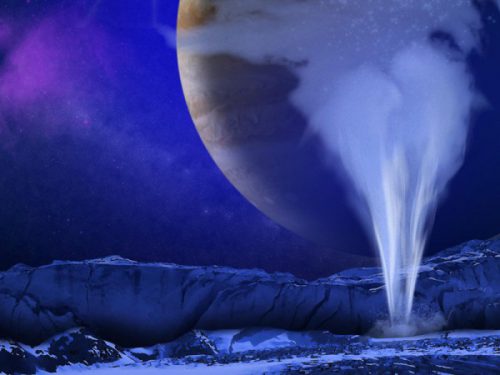
“We are studying a lander. Our analysis shows that it makes the most sense to launch it about 2 years after Clipper is launched. We currently have a Science Definition Team working on finalizing the scientific goals of the lander, but its primary objective will be to search for evidence of life. It will land, use a drill of some kind to collect ice samples, and then deliver the samples to science instruments for analysis.”
Landing on Europa would of course be exciting, and a lander could target a spot on the surface where material from the ocean below has come up to the surface, which is already thought to happen in some of the large “cracks” in the icy surface which make Europa kind of look like a giant cracked round egg. There is already evidence that Europa’s ocean has a composition similar to Earth’s. If there are any hydrothermal vents on the ocean floor, they could provide heat and nutrients, just as they do on Earth. There is already evidence for hydrothermal activity on the ocean floor of Saturn’s moon Enceladus, which also has a global subsurface ocean.
There may also be water vapor geysers on Europa, similar to ones on Enceladus, but they haven’t been confirmed yet. If there are, a probe could fly through them and analyze what is in them, just like Cassini has already done, passing through Enceladus’ plumes several times now. In the case of Enceladus, Cassini’s instruments have found water vapor, ice particles, salts, and organics in the plumes.
The overall goal of a Europa mission is, of course, to look for possible evidence of life. The Europan ocean would be dark and cold, but even in similar environments on Earth, life flourishes. As Niebur noted: “Mission success, in NASA’s mind for this mission, which is 23 or so days long, is that on day 25 we have a press conference at NASA Headquarters and announce that we’ve found life. If that is an unrealistic expectation, I need to know it now and not on day 22 of the mission.”
Is there anything living in that alien ocean? Europa Clipper and a possible lander mission might be able to answer that question, but it’s also possible that another mission, drilling through the ice to the water below, will be necessary. The ocean itself is deep below, but there are also now thought to be smaller lakes within the ice crust, closer to the surface. However, such a mission is still a long ways off.
Europa is not only a world that we would like to return to, but one that we need to return to. Along with Enceladus, it offers the best chance in the near future for finding evidence of life elsewhere in the Solar System. Even if that life was only microbes, it would be humanity’s greatest discovery so far.
Want to keep up-to-date with all things space? Be sure to “Like” AmericaSpace on Facebook and follow us on Twitter: @AmericaSpace
Missions » Europa Mission »



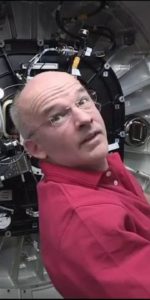

This mission is if profound scientific and technological importance. Let’s hope clear-headed minds keep the funding intact. Too much is at stake.
(of)
There’s no logical reason to prioritize a mission to Europa– at this time.
NASA should be squarely focused on understanding the geology of the Lunar poles and the water and other elements that exist there and the geology of the moons of Mars– including extensive sample retrieval missions.
Since you cannot divorce your Mars fantasy from the practical reality of a Moon base no one is going to be swayed by your appeal. The opposite result is likely.
Cut F-35. Give its budget to Europa
Humans and robots climb out of Earth’s gravity well to see what is interesting and useful beyond our lovely Blue Sphere.
Robot, and someday human, missions to explore Europa’s hidden ocean and lakes have interesting long-term implications for folks like us who are water based creatures.
“As Europa receives 540 rem of radiation per day,[2] a human would not survive at or near the surface of Europa for long without significant radiation shielding. Colonists on Europa would have to descend beneath the surface when Europa is not protected by Jupiter’s magnetotail, and stay in subsurface habitats. This would allow colonists to use Europa’s ice sheet to shield themselves from radiation.”
From: ‘Colonization of Europa’ Wikipedia
At: https://en.wikipedia.org/wiki/Colonization_of_Europa
“The rem is defined since 1976 as equal to 0.01 sievert, which is the more commonly used SI unit outside of the United States.”
And, “One rem carries with it a 0.055% chance of eventually developing cancer.[2] Doses greater than 100 rem received over a short time period are likely to cause acute radiation syndrome (ARS), possibly leading to death within weeks if left untreated.”
From: ‘Roentgen equivalent man’ Wikipedia
At: https://en.wikipedia.org/wiki/Roentgen_equivalent_man
I’m looking forward to seeing the results of these robot Europa missions.
Thank you Paul Scott Anderson for another informative article!